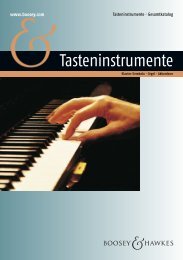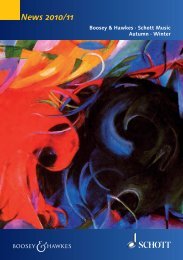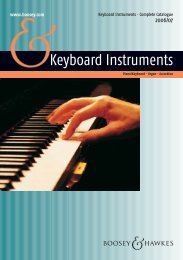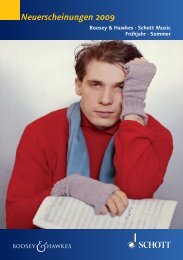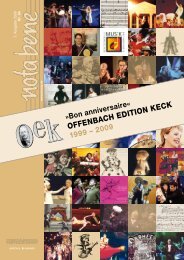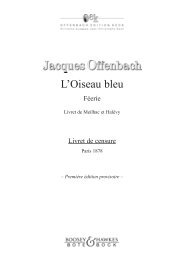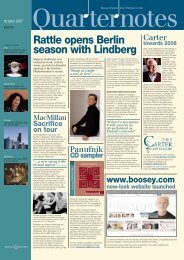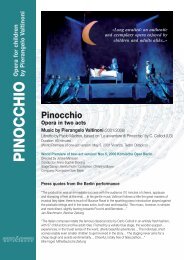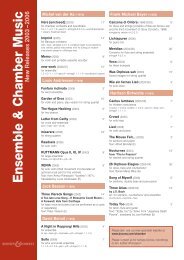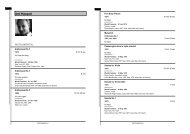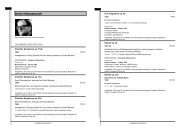New Composers Rachmaninoff
New Composers Rachmaninoff
New Composers Rachmaninoff
You also want an ePaper? Increase the reach of your titles
YUMPU automatically turns print PDFs into web optimized ePapers that Google loves.
Photo: Matt Stuart<br />
Andriessen La Commedia<br />
Louis Andriessen discusses his new opera, premiered in Amsterdam on 12 June.<br />
When was your interest in Dante’s La<br />
Commedia first kindled?<br />
I’ve had an ongoing interest in Dante<br />
for close on 30 years. At the time of<br />
writing De Tijd I was researching<br />
possible texts in Florence. The work<br />
finally ended up using a text by St<br />
Augustine, but I did retain as a motto<br />
a phrase from the Paradiso section of<br />
Commedia that describes “gazing on<br />
the point beyond which all times are<br />
present”.<br />
How did the idea for a full-length<br />
opera come into being?<br />
I’d always wanted to return to<br />
Dante’s Florence by writing in Italian,<br />
and this came about through hearing the singer<br />
Cristina Zavalloni, who for me was the first since<br />
Cathy Berberian to produce the right vernacular<br />
quality. I wrote Racconto dall’inferno for her, a<br />
grotesque scherzo setting texts from the Inferno<br />
section of La Commedia, and the idea of a fullevening<br />
stagework grew from there, with Racconto as<br />
the second of the five scenes.<br />
What in essence does opera mean to you?<br />
The nineteenth century opera tradition has never<br />
meant a lot to me – my favourite operas are the Bach<br />
Passions. I’ve probably spent more of my time<br />
watching movies, whether Tom and Jerry or Fellini.<br />
But I have always been interested in theatre, and its<br />
relations with other artforms including singing. I’ve<br />
worked in theatres from the age of 14 and was<br />
particularly active in this area in the 1970s with the<br />
Baal group, which tried to recapture the spirit of<br />
Brecht and Weill. This led to all manner of mixedmedia<br />
collaborations including film and dance as well<br />
as music.<br />
You’ve titled La Commedia a ‘film opera’ and are<br />
working with director Hal Hartley.<br />
Yes, we were brought together for the first time in<br />
2000 on a short film with music called The <strong>New</strong><br />
Math(s), and then on a theatre project Inanna. My<br />
experience working with visual artists is that you can<br />
suggest a few images but largely you have to allow<br />
their mind’s eye to work – it was the same<br />
collaborating with Robert Wilson for De Materie and<br />
with Peter Greenaway. With Hal Hartley I’ve spent<br />
most time discussing moods and my choices of texts,<br />
and how ideas are linked to the paintings of heaven<br />
and hell by Hieronimus Bosch. The film footage is<br />
totally contemporary, but I’ve seen a section where a<br />
gang of street musicians is a perfect modern<br />
equivalent to a Bosch painting.<br />
MacMillan<br />
St John Passion<br />
“James MacMillan has delivered a St John Passion<br />
that stirred its premiere audience to a standing<br />
ovation.” So wrote The Independent, witnessing the<br />
spontaneous public response to this major new<br />
choral-orchestral work, composed as an 80th<br />
birthday present for Sir Colin Davis at the helm of the<br />
London Symphony Orchestra and Chorus. The first<br />
performance was clearly as significant for the religious<br />
as for the musical community, as noted by The<br />
Observer: “It is not often you see the Archbishop of<br />
Canterbury lead a standing ovation… Clearly, the<br />
archbishop shared the ecstatic audience’s view that a<br />
great new work had entered the repertoire”.<br />
James MacMillan with Sir Colin Davis at rehearsals.<br />
In recent years Colin Davis has championed<br />
MacMillan’s music, making the composer a natural<br />
choice to create this special score. Following the<br />
London premiere and recording for the LSO Live<br />
label, Davis will conduct performances of the St John<br />
Passion with the Royal Concertgebouw Orchestra in<br />
Amsterdam on 8/9 April 2009, and with the Boston<br />
Photo: Francesca Patella<br />
How did you select the texts from the<br />
complete Commedia?<br />
The first principle was to select<br />
sequences of material in the same<br />
order as in Dante’s book. So the first<br />
two scenes take us from the City of<br />
Dis down through Inferno to the<br />
deepest regions of hell where we<br />
meet Lucifer in the third part. This is<br />
where Adam’s Fall is described. We<br />
then pass upward through the lighterhearted<br />
Garden of Earthly Delights<br />
until we reach Paradise in the final<br />
section, Eternal Light.<br />
How do the comic and serious<br />
elements balance in the work?<br />
This is quite a complicated question to answer. Dante<br />
would simply have viewed comedy in the Greek<br />
sense where it is a form of serious drama that has a<br />
happy ending. The adjective ‘Divine’ was only added<br />
to Dante’s title in the 16th century, some 200 years<br />
after the book’s completion around 1320, so the<br />
religious aspect of Commedia is really only within an<br />
overall social, political and essentially humanist<br />
framework. This is why I view the text as being more<br />
concerned with our life on earth than with any afterlife,<br />
and Dante’s comic vehicle for this observation was<br />
irony, which really appealed to me. Irony is what<br />
generates the drama in my opera – a satirical view of<br />
heaven and hell in our everyday life. There are comic<br />
and serious sides to this irony which play off each<br />
other in a dialectic manner. The lightness is balanced<br />
with melancholy – something I also hear in the music<br />
of Stravinsky and Poulenc - and I’ve tried to offset<br />
serious with popular music, such as in the swinging<br />
jazz clarinet music that leads us into the Garden of<br />
Earthly Delights.<br />
How did you decide on the vocal forces for the<br />
opera?<br />
I’ve always been more interested in working with<br />
singing actors than acting singers. So the three<br />
principal voices in the opera are not conventional<br />
types. As well as being a contemporary music<br />
specialist, Claron McFadden who sings Beatrice is a<br />
baroque singer with a background in soul and gospel.<br />
Cristina Zavalloni worked first in jazz and experimental<br />
music and brings a unique timbre and Jeroen Willems<br />
is foremost an actor but is also a great performer of<br />
the songs of Jacques Brel. Rather than personifying<br />
the roles of Dante and Lucifer, those two singers<br />
function more as commentators. Then there is a small<br />
chorus of eight solo voices, and a children’s choir that<br />
appears in the final scene.<br />
Symphony Orchestra in the 2009/10 season. The<br />
German premiere takes place on 14 March 2009 with<br />
the Rundfunkchor and Sinfonierchester Berlin<br />
conducted by Simon Halsey.<br />
The vocal forces for the St John Passion are skilfully<br />
layered: a small, plainsong-inflected ensemble<br />
narrates events as if from a timeless illuminated<br />
manuscript, while the full chorus switches between<br />
the mob outbursts of the turba and a series of<br />
reflective motets. The dramatic core of the work is<br />
focused on the baritone role of Christ, “sung with<br />
awesome authority by Christopher Maltman…<br />
MacMillan gives Christ elaborate, declamatory<br />
passages full of anger and bitterness. This is not a<br />
saviour going submissively to the cross, but a<br />
furious rebel” (The Observer).<br />
“Davis is a wily conductor, and never have his instincts<br />
been more accurate. For MacMillan has come up with a<br />
masterly work that has all the hallmarks of a 21st-century<br />
classic… MacMillan is a master of ratcheting up the<br />
tension, building the drama, his subtle use of syncopation<br />
adding to the effect. But he can also turn his hand to the<br />
most lyrical, vulnerable music. There is a tremendous<br />
sense of wonder for Christ’s “This is my body” passage,<br />
and again for the Crucifixus, a dream-like sequence that<br />
seems to exist in another dimension… There is another<br />
mesmerizing passage in “Jesus and his Mother” where the<br />
two choruses sing together, interweaving their lines with<br />
great beauty.”<br />
Musical America<br />
“A riveting and remarkable<br />
work; a new-minted classic”<br />
The Scotsman<br />
“A blazing blockbuster, a piece as fiercely communicative<br />
as anything that the 48-year-old MacMillan has written<br />
before…. The end of Part One was masterly: no<br />
loudspeaker wailing as the Crucifixion loomed, but a<br />
resigned, pianissimo meditation, threaded with keening<br />
instrumental solos.” The Times<br />
“The compelling performance transcended the score’s<br />
significant technical demands to underline the depth of<br />
feeling and tremendous emotional impact that MacMillan<br />
has achieved in this powerful score.” Daily Telegraph<br />
Photo: Eric Richmond/ArenaPAL<br />
Are there any special features in the orchestration?<br />
The orchestra is a little smaller than my typical large<br />
ensemble of the 1980s: triple winds, double brass,<br />
two pianos, two percussionists and strings without<br />
violas. As well as a harp there is a plucked combo of<br />
cimbalom, guitar and bass guitar which give some<br />
sections of the score a distinctive, perhaps medieval<br />
colour. I haven’t gone out of my way to create a<br />
period sound as I did with Writing to Vermeer, though<br />
I did decide against having synthesiser keyboards<br />
which wouldn’t have sounded right. In addition to the<br />
orchestra, I asked Anke Brouwer to provide a series<br />
of electronic soundscapes. Sometimes these are<br />
heard alone and sometimes they add a particular<br />
coloration to the orchestral sound.<br />
How does the opera fit into your output – is it in some<br />
ways summatory?<br />
Well, that’s really for others to judge. It has occupied<br />
my thoughts for many years, and perhaps there are<br />
more cross references and allusions to other music in<br />
this score. So this is different to my usual approach of<br />
creating self-contained sections of music. I have<br />
found myself examining earlier pieces dealing with<br />
similar issues, but I haven’t created a grand summing<br />
up. Even in the final section which could have finished<br />
with celestial choirs, I decided on an amusing surprise<br />
finale like in Don Giovanni or Gianni Schicchi. The kids<br />
run back onto stage to sing this message from Dante:<br />
“These are my notes and if you don’t understand<br />
them, you’ll never understand the Last Judgement”.<br />
Andriessen<br />
La Commedia (2004-08)<br />
Film opera in five parts<br />
Texts by Dante, Vondel and others, and from the Old<br />
Testament<br />
Electronic inserts by Anke Brouwer<br />
Commissioned by the Netherlands Opera<br />
Reinbert de Leeuw Conductor<br />
Hal Hartley Director<br />
Beatrice: Claron McFadden<br />
Dante: Cristina Zavalloni<br />
Lucifer: Jeroen Willems<br />
Asko Ensemble/Schoenberg Ensemble/<br />
Synergy Vocals<br />
Netherlands Opera<br />
12 June 2008 (world premiere)<br />
14/15/16/17/18 June 2008<br />
Holland Festival<br />
Koninklijk Theater Carré, Amsterdam<br />
www.dno.nl<br />
Chin<br />
Rocana -<br />
On 3 March the Orchestre<br />
Symphonique de Montréal<br />
premiered Unsuk Chin’s<br />
new orchestral piece<br />
Rocana - , the Sanskrit title<br />
describing a ‘room of light’<br />
here transformed into the<br />
composer’s kaleidoscopic<br />
soundworld. Following the<br />
premiere Kent Nagano<br />
toured with the orchestra to<br />
Carnegie Hall in <strong>New</strong> York<br />
and conducted further<br />
performances in April with<br />
the Chicago Symphony<br />
Orchestra. The work was<br />
co-commissioned by the Bayerische Staatsoper,<br />
Seoul Philharmonic and the Beijing Festival, and<br />
performances are scheduled for Beijing in October<br />
and Munich in February 2009.<br />
“…a continuous 20-minute score Chin has crafted as a field<br />
of unquiet aural dreams. She is fascinated by the volatility of<br />
orchestral sounds and how they evolve into other, seemingly<br />
unrelated musical events, travelling in waves as light does.<br />
Her huge orchestral palette is laced with all manner of<br />
percussion, including Japanese temple bells and a<br />
xylophone of stones. At times, she employs it as sparingly as<br />
a neo-pointillist painter; at other times, violent chords<br />
ricochet around the brasses, turning the ensemble into a<br />
mechanistic juggernaut.” Chicago Tribune<br />
“The piece is a knockout. It begins with a gnarly, clattering,<br />
explosion…Then comes a pattern of background<br />
harmonies, always simmering, eerily quiet and pervasive. But<br />
throughout the work, jolts of energy keep happening: leaping<br />
lines, ominous 12-tonish themes that pierce the tranquil<br />
background buzz, outbursts of wailing brasses and metallic<br />
strings that come at you like a musical flamethrower.”<br />
<strong>New</strong> York Times<br />
Photo: Theater Hagen<br />
Adam<br />
authentic<br />
Giselle<br />
Following the launch last year of the new Boosey &<br />
Hawkes performing edition of Adolphe Adam’s<br />
Giselle, the version by David Garforth is being taken<br />
up as the definitive way to perform the music of this<br />
ballet classic as the composer intended.<br />
Acclaimed when created for the ballet of the Teatro<br />
alla Scala Milan, the version has already formed the<br />
basis of new Giselle choreographies at the Ballet de<br />
Nice and at the Theater Hagen by Monique<br />
Loudieres and Ricardo Fernando respectively.<br />
While many may view the traditional ‘corrupt’<br />
versions of Giselle as overblown and inauthentic, the<br />
Wesfalenpost praised the new staging in Hagen as<br />
“a refreshing, up-to-date, yet approachable<br />
version… greeted with bravo calls and a standing<br />
ovation”. The edition follows a review of manuscripts<br />
at the Bibliothèque Nationale de France and La<br />
Scala Milan, not only returning to Adam’s original<br />
lighter-textured orchestration true to the French<br />
Romantic ballet style, but also restoring options for<br />
music cut for the first performance. High-quality new<br />
materials are available on hire, including a fully<br />
compatible piano score in addition to the orchestral<br />
score and parts.<br />
Giselle at the Theater Hagen, danced to the new performing<br />
edition of Adam’s ballet.<br />
<strong>New</strong> opera hig<br />
Symphonic suites and operatic interludes<br />
provide concert audiences with a<br />
dramatic introduction to the latest operas.<br />
John Adams<br />
Doctor Atomic Symphony (2007) 25’<br />
Highlights drawn by John Adams from Doctor Atomic have<br />
now reached their final form as a single-movement<br />
symphony. This version drew unanimous praise when<br />
performed by the Saint Louis Symphony in February.<br />
“As 25 minutes of gripping instrumental theater, the Doctor Atomic<br />
Symphony gives the opera a tremendous amount to live up to. The<br />
opening doesn’t so much set a scene as pin listeners to their chairs<br />
with a high-impact wave of sound... What follows constitutes Adams’<br />
most texturally arresting orchestral work yet.” The Star Ledger<br />
A new production of Doctor Atomic by Penny Woolcock, who<br />
directed the award-winning film of The Death of Klinghoffer,<br />
opens at the Metropolitan Opera in <strong>New</strong> York in October and<br />
travels to English National Opera in London in February 2009.<br />
The original Peter Sellars production of the opera will be<br />
released on DVD by Opus Arte in September.<br />
Unsuk Chin<br />
snagS & Snarls (2003-04) 14’<br />
Fantasy-filled scenes from Unsuk Chin’s opera Alice in<br />
Wonderland have proved popular in concert as snags &<br />
Snarls. These five songs, premiered by the Los Angeles<br />
Opera Orchestra, reveal an ideal match between the<br />
wordplay in Lewis Carroll’s text and the musical games in<br />
Chin’s music, whether the pointillist teardropping syllables of<br />
Who in the world am I, the violent assault and cries of Speak<br />
roughly to your little Boy, or the Mad Tea-Party setting of<br />
Twinkle, twinkle, little Star.<br />
The Bavarian State Opera production of Alice in Wonderland<br />
is now available as a DVD from Unitel Classica, with a cast<br />
including Sally Matthews, Dietrich Henschel and Gwyneth<br />
Jones stealing the show as the Queen of Hearts.<br />
Brett Dean<br />
Moments of Bliss (2004) 25’<br />
Brett Dean’s virtuoso orchestration and subtle blending of<br />
electronic elements can be heard to full advantage in<br />
Moments of Bliss. The four studies towards his Peter Carey<br />
opera encompass dark satire, cardiac catastrophe, a vision of<br />
hell as a game-show, and a moving elegy. The suite has been<br />
performed by Markus Stenz with the Melbourne Symphony,<br />
Gürzenich Orchestra Cologne and the BBC Philharmonic.



